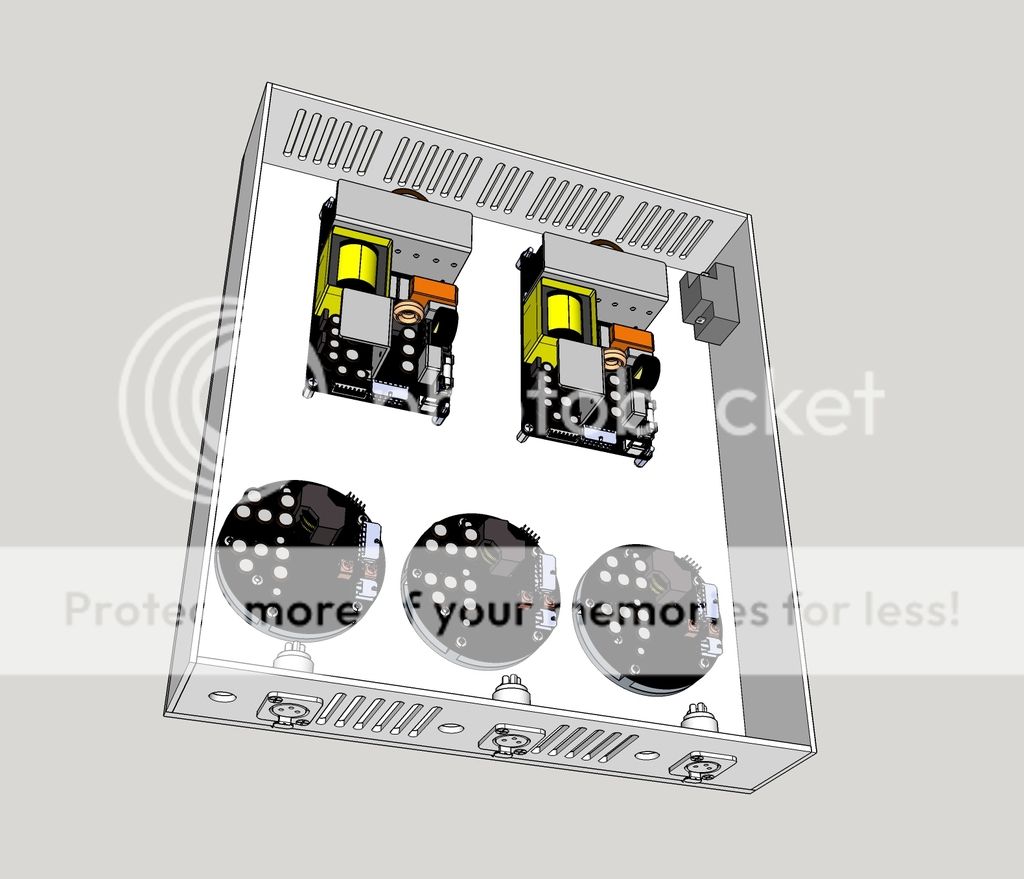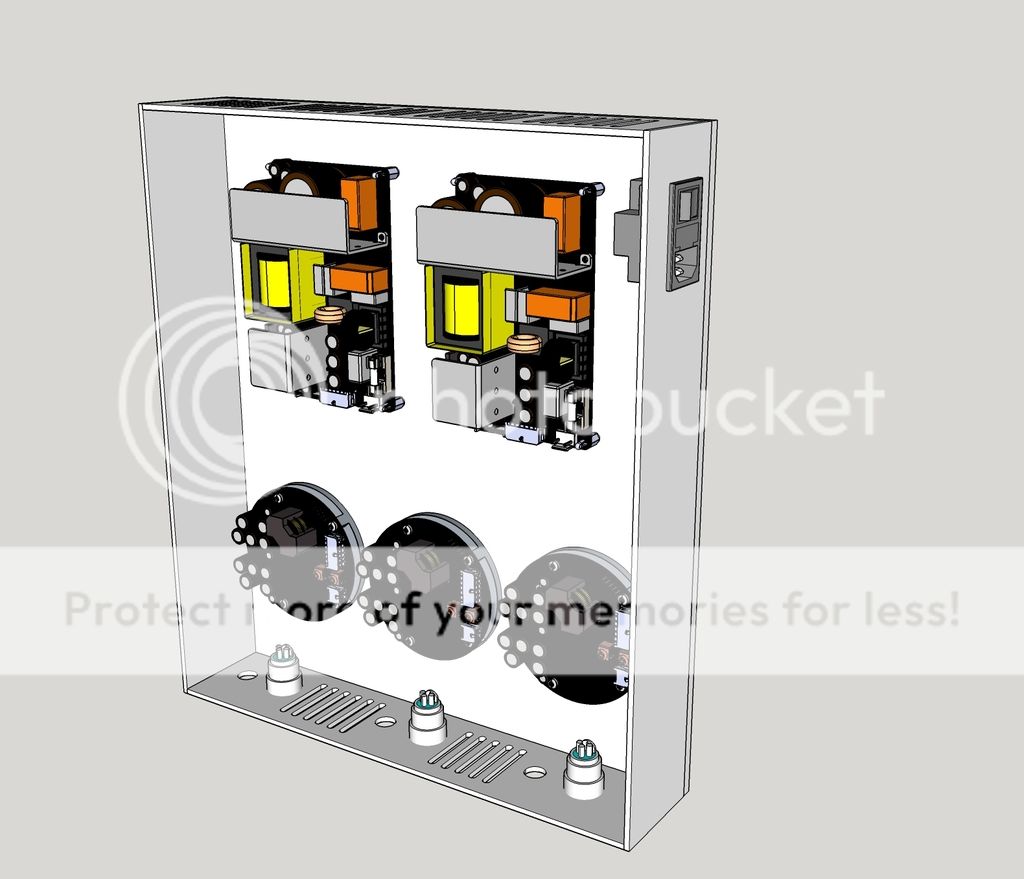Even on a powerful desktop PC with a bunch of memory that makes them slow to manipulate in Sketchup.
I'll spend some time removing detail from them if I have to but thought I would ask if anyone has a better model.
Thanks,
Chris
50 and 30MB sounds like pretty easy for a modern PC. Maybe it is just the software. You can try DesignSpark Mechanical. It's more made fore these kind of things...
50 and 30MB sounds like pretty easy for a modern PC. Maybe it is just the software. You can try DesignSpark Mechanical. It's more made fore these kind of things...
Those are huge files as far as sketchup models go. My model for the speaker I'm working on saves into a file less than 1MB. So importing the NC400 and SMPS600 models would increase my file size by almost 80 times.
Thanks for the suggestion on DesignSpark but I already know how to do things in Sketchup and it works fine for me. The size problem seems to be from importing the Solidworks models provided by Hypex.
It's not that big of a deal overall but maybe somebody does have a smaller Sketchup file so can't hurt to ask.
-Chris
I'm building a pretty large 3 way speaker and I want to mount Hypex modules to the back. I'll start with a single SMPS600 and two NC400 modules per speaker, which will power my tweeters and midrange. But I want to have room for adding another NC400 with a dedicated SMPS600 to each speaker later, to power my woofers.
What do you guys think of the layout below? I would use a piece of aluminum as the base and bend it to form the bottom side where the XLR connectors will be mounted. Then probably make the other sides and top from wood or maybe acrylic.
I would just run wires through grommets on the bottom for the speaker outputs and terminate them with speakon connectors. They would plug in to speakon inputs on the speaker enclosure, below the amp panel.
I'm wondering if having the AC power cord running up the outside of the panel with a 90 degree plug is a bad idea though. Any thoughts on that?
Thanks,
Chris


What do you guys think of the layout below? I would use a piece of aluminum as the base and bend it to form the bottom side where the XLR connectors will be mounted. Then probably make the other sides and top from wood or maybe acrylic.
I would just run wires through grommets on the bottom for the speaker outputs and terminate them with speakon connectors. They would plug in to speakon inputs on the speaker enclosure, below the amp panel.
I'm wondering if having the AC power cord running up the outside of the panel with a 90 degree plug is a bad idea though. Any thoughts on that?
Thanks,
Chris


I'm wondering if having the AC power cord running up the outside of the panel with a 90 degree plug is a bad idea though. Any thoughts on that?
Why do you think it would be a bad idea?
Why do you think it would be a bad idea?
Just not sure if it would be too close to the amp modules or signal wiring like that and create a 60Hz hum.
Do you think it will be good as long as I twist the wires inside the case?
Thanks,
Chris
Just not sure if it would be too close to the amp modules or signal wiring like that and create a 60Hz hum.
Do you think it will be good as long as I twist the wires inside the case?
Yes, I think you will be fine as long as you don't have long parallel runs of wiring next to the mains cable.
I'm wondering if having the AC power cord running up the outside of the panel with a 90 degree plug is a bad idea though. Any thoughts on that?
Chris,
instead of a normal AC plug that could be easily disconnected, I would use a powercon instead. it looks like a speakon plug but designed for AC. This kind of plug are locked by either a turn or a push button.
instead of a normal AC plug that could be easily disconnected, I would use a powercon instead.
Are there 90 degree powercons?
The flip side (pun intended) would be flip the orientation 180* so the power section is on the bottom and the amps on top.I'm building a pretty large 3 way speaker and I want to mount Hypex modules to the back. I'll start with a single SMPS600 and two NC400 modules per speaker, which will power my tweeters and midrange. But I want to have room for adding another NC400 with a dedicated SMPS600 to each speaker later, to power my woofers.
What do you guys think of the layout below? I would use a piece of aluminum as the base and bend it to form the bottom side where the XLR connectors will be mounted. Then probably make the other sides and top from wood or maybe acrylic.
I would just run wires through grommets on the bottom for the speaker outputs and terminate them with speakon connectors. They would plug in to speakon inputs on the speaker enclosure, below the amp panel.
I'm wondering if having the AC power cord running up the outside of the panel with a 90 degree plug is a bad idea though. Any thoughts on that?
Thanks,
Chris


I would just run wires through grommets on the bottom for the speaker outputs and terminate them with speakon connectors. They would plug in to speakon inputs on the speaker enclosure, below the amp panel.
Personally I would prefer using one or two speakon chassis sockets (there are models with 2, 4 and 8 poles) and detachable cables instead. It would look neater, be more versatile for other setups. Moreover, and apparently important: I would twist the speaker wires inside the enclosure and know that they stay twisted. With your idea this last point might be difficult to achieve.
Chris,
instead of a normal AC plug that could be easily disconnected, I would use a powercon instead. it looks like a speakon plug but designed for AC. This kind of plug are locked by either a turn or a push button.
When I first read this I was thinking that's definitely something I will try to do. But after thinking a little more, I can't think of a time when I've had the power cable accidentally disconnect from a normal IEC connector.
I guess it could vibrate out though with the amps mounted to the speaker as I'm planning. I'll see what kind of right angle connectors I can find.
Thanks,
Chris
The flip side (pun intended) would be flip the orientation 180* so the power section is on the bottom and the amps on top.
That's the way I started out drawing it but swapped it for aesthetic reasons. I just think it will look much cleaner to have the signal in and speaker out on the bottom.
I may play around with the layout more though.
Thanks,
Chris
Personally I would prefer using one or two speakon chassis sockets (there are models with 2, 4 and 8 poles) and detachable cables instead. It would look neater, be more versatile for other setups. Moreover, and apparently important: I would twist the speaker wires inside the enclosure and know that they stay twisted. With your idea this last point might be difficult to achieve.
That's a good point about the twisting. Another thing is strain relief on the speaker wires. Might be able to use a wire clamp anchored to the chassis to deal with both.
I'll look at some different speakon connectors to see what kind of layout options they may provide.
Thanks,
Chris
What does ncX00 'sound' like if wires are not twisted, please? Thanks
I.e. What detrimental effect may be audible?
Mainly noise. Mains noise is easy to hear, HF noise (and oscillation) less so, but easy to see on a scope.
Thanks Julf, but what sort of noise? Are you able to describe the effect? Buzz, muddy bass, fuzzy midrange etc? Thanks again
Could be all of those
It is hard to describe, because it is hard to predict. Depends on the kind of HF noise you have in your environment, and how it interacts (through intermodulation) with your signal. There will most likely be a higher level of broadband background noise (heard as a vague hiss), but it is tricky to guess how the intermodulation effects sound - most likely muddiness/fuzziness (but those are subjective descriptions - the words might not mean the same for me as for you).
Thanks. Am trying to gauge if it's something in my build. So far, my nCore amp has been the grainer sounding in every place I've tried it...took to another neighbour for shootout recently and wondering if it's picking up noise somewhere/somehow - main thing is the brash treble and I'm starting to really hate this amp now; I no longer enjoy listening to my music :-( ...the presentation is also a bit bland and univolving compared to other amps I've tried against it, less depth and worry it's noise causing this if these amps are supposed to be so clean
Thanks. Am trying to gauge if it's something in my build.
Do you have anyone in your area that has an oscilloscope? Maybe a local hacker/makerspace?
So far, my nCore amp has been the grainer sounding in every place I've tried it...took to another neighbour for shootout recently and wondering if it's picking up noise somewhere/somehow - main thing is the brash treble and I'm starting to really hate this amp now; I no longer enjoy listening to my music :-( ...the presentation is also a bit bland and univolving compared to other amps I've tried against it, less depth and worry it's noise causing this if these amps are supposed to be so clean
What kind of amps have you been comparing against?
Influence of SMPS?
It's a pity that nobody seriously compared SMPS with a high quality linear supply.
Because everybody presumes a SMPS to be superior....because someone said so....
I would not be surprised if part if not all of complaints would disappear with a well designed linear supply (but I realize I am a calling one in the desert......haha is that well translated???)
It's a pity that nobody seriously compared SMPS with a high quality linear supply.
Because everybody presumes a SMPS to be superior....because someone said so....
I would not be surprised if part if not all of complaints would disappear with a well designed linear supply (but I realize I am a calling one in the desert......haha is that well translated???)
- Status
- Not open for further replies.
- Home
- Amplifiers
- Class D
- Hypex Ncore